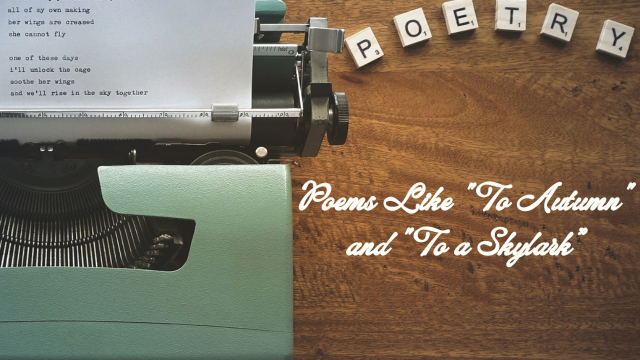Poems Like “To Autumn” and “To a Skylark”: Exploring Romantic Odes to Nature
The Romantic era in literature is renowned for its intense emotional expression and deep reverence for nature. Poets such as John Keats and Percy Bysshe Shelley became instrumental in exploring the relationship between humanity and the natural world. Two of the most celebrated works from this period are Keats’ “To Autumn” and Shelley’s “To a Skylark”. If you are looking for poems like To Autumn and To a Skylark, you’ll find a rich tradition of Romantic odes that delve into nature’s beauty, the passage of time, and the human condition.
In this post, we will explore the unique qualities of these poems and discuss other notable works that share similar themes. We will examine how these poems fit into the larger context of Romanticism, while also delving into their artistic qualities, themes, and significance.
The Essence of Romantic Nature Poetry
Romantic poetry emphasizes personal emotions, the sublime in nature, and a profound connection to the natural world. The movement was a reaction against the Enlightenment, which prioritized reason and scientific thinking over emotional depth. Romantic poets turned to nature not just as an inspiration but as a source of truth and moral understanding.
Key Characteristics of Romantic Nature Poetry
- Emotional Depth: Romantic poets used nature to evoke deep emotional responses, often reflecting on beauty, mortality, and transcendence.
- Idealization of Nature: Nature is seen as a pure and untainted force, often offering solace in contrast to the corruption of industrialized society.
- Focus on the Sublime: Romantic poetry often explores the overwhelming power and majesty of nature, inspiring both awe and terror.
These elements are foundational to understanding poems like “To Autumn” and “To a Skylark”. Let’s take a deeper look at these poems before expanding our focus to similar works.
John Keats’ “To Autumn”: A Celebration of the Seasons
Keats’ “To Autumn”, written in 1819, is considered one of his greatest works and a quintessential example of nature poetry. Unlike many of his other odes that dwell on themes of transience and melancholy, “To Autumn” offers a sense of acceptance and peace with the natural cycles of life.
Analysis of “To Autumn”
The poem is divided into three stanzas, each celebrating a different phase of the autumn season.
- First Stanza: The season is personified as a “close-bosom friend of the maturing sun,” emphasizing a symbiotic relationship between nature and time. The imagery here is lush and sensuous, celebrating the abundance of the harvest.
- Second Stanza: The second stanza shifts to the middle of autumn, where the season is portrayed as a figure at rest, enjoying the fruits of its labor. There is a serene calmness here, as if autumn itself is pausing to appreciate its accomplishments.
- Third Stanza: In the final stanza, Keats contemplates the inevitable decline of autumn as winter approaches. Yet, rather than lamenting the change, he embraces it. The song of spring is replaced by the “soft-dying” music of autumn, symbolizing the beauty found in all stages of life.
Themes in “To Autumn”
- Cycles of Life and Death: Keats’ treatment of autumn reflects his broader interest in the passage of time and the natural cycle of life and death.
- Acceptance and Maturity: Unlike earlier works where Keats grapples with existential angst, “To Autumn” reflects a mature acceptance of life’s inevitable transitions.
The beauty of “To Autumn” lies in its ability to capture the fullness of life in a single season, making it one of the most enduring nature poems in English literature.
Percy Bysshe Shelley’s “To a Skylark”: A Vision of Transcendence
In contrast to Keats’ focus on the earthbound cycle of seasons, Shelley’s “To a Skylark” (1820) soars into the heavens with a sense of spiritual elevation. The skylark, a small bird known for its high, melodious flight, becomes a metaphor for artistic inspiration and pure joy in this poem.
Analysis of “To a Skylark”
“To a Skylark” is structured as a sequence of five-line stanzas, with the first four lines rhyming alternately, followed by a concluding couplet. Shelley’s approach allows for both lyrical expression and philosophical reflection.
- First Stanza: The poem begins with a direct address to the skylark, whose song is described as a “blithe Spirit” that ascends higher and higher, far beyond the reach of the speaker.
- Middle Stanzas: Shelley’s admiration for the skylark intensifies as he contrasts its carefree existence with the sorrows of human life. The skylark’s song is “unbidden,” natural, and untroubled by the fears and desires that plague humanity.
- Final Stanzas: The poet longs to know the secret of the bird’s happiness, concluding that the skylark embodies an ideal form of existence, free from suffering and grounded in the pure joy of being.
Themes in “To a Skylark”
- Transcendence: Shelley uses the skylark to explore the theme of transcendence, where the bird’s flight symbolizes the soul’s ability to rise above worldly troubles.
- Artistic Inspiration: The skylark’s spontaneous song mirrors the ideal form of poetic creation, which arises from an untainted source of inspiration.
Shelley’s skylark, unlike Keats’ autumn, exists beyond the temporal world, representing an ethereal form of beauty and inspiration.
Poems Similar to “To Autumn” and “To a Skylark”
Many poems from the Romantic era share the themes of nature, transcendence, and emotional reflection found in “To Autumn” and “To a Skylark”. Here are a few notable works:
William Wordsworth’s “Tintern Abbey”
Wordsworth’s “Lines Composed a Few Miles Above Tintern Abbey”, often referred to as “Tintern Abbey”, is another landmark of Romantic nature poetry. In this poem, Wordsworth reflects on his deep connection to the landscape around him and the spiritual renewal that nature offers.
- Themes: Like “To Autumn”, “Tintern Abbey” emphasizes the passage of time, with Wordsworth reflecting on how his perception of nature has matured. Both poems celebrate nature’s ability to provide solace and wisdom.
Samuel Taylor Coleridge’s “Frost at Midnight”
Coleridge’s “Frost at Midnight” is a meditative poem that contemplates the stillness of nature during a cold winter night. In the quiet, Coleridge reflects on his inner thoughts and the importance of nature in shaping his imagination.
- Themes: Similar to “To a Skylark”, “Frost at Midnight” explores the idea of inspiration and the way nature influences the human mind and spirit.
William Blake’s “The Tyger”
While more abstract than Keats or Shelley’s work, Blake’s “The Tyger” engages with the natural world in a symbolic manner, pondering the mystery of creation and the duality of beauty and terror.
- Themes: Blake’s exploration of the sublime in nature mirrors the awe Shelley feels toward the skylark. Both poets explore nature’s capacity to inspire a sense of wonder that borders on the divine.
John Clare’s “The Peasant Poet”
John Clare, often called the “peasant poet,” wrote extensively about rural life and the natural world. His poem “The Peasant Poet” offers a more grounded, realistic portrayal of nature compared to the idealized visions of Keats and Shelley.
- Themes: Clare’s work aligns with Keats’ appreciation for the earthbound and seasonal aspects of nature, emphasizing the beauty in simplicity and everyday life.
Conclusion
Poems like “To Autumn” and “To a Skylark” reflect the Romantic era’s deep engagement with nature, emotion, and the human spirit. While Keats focuses on the earthly beauty of the natural cycle, Shelley reaches toward the sky, searching for transcendence and artistic purity. Together, these poems encapsulate the wide-ranging emotions and ideas that define Romantic poetry.
Their themes of acceptance, inspiration, and the sublime have resonated with readers for centuries, influencing countless other poets. As we explore these works, we are reminded of the enduring power of nature to inspire awe, comfort, and artistic expression.
FAQs
1. What is the central theme of “To Autumn” by John Keats?
The central theme of “To Autumn” is the passage of time and the beauty of nature’s cycles. Keats celebrates autumn’s richness while accepting the inevitability of change and decline.
2. What does the skylark symbolize in Shelley’s “To a Skylark”?
In “To a Skylark”, the skylark symbolizes artistic inspiration, joy, and transcendence. Its song is portrayed as a pure expression of happiness, untainted by human suffering.
3. How do “To Autumn” and “To a Skylark” differ in their portrayal of nature?
“To Autumn” focuses on the grounded beauty of the earth’s seasonal cycles, while “To a Skylark” looks beyond the earthly realm to







